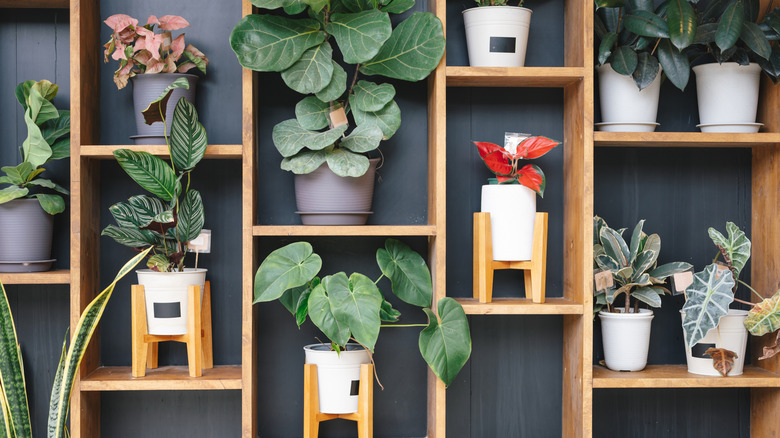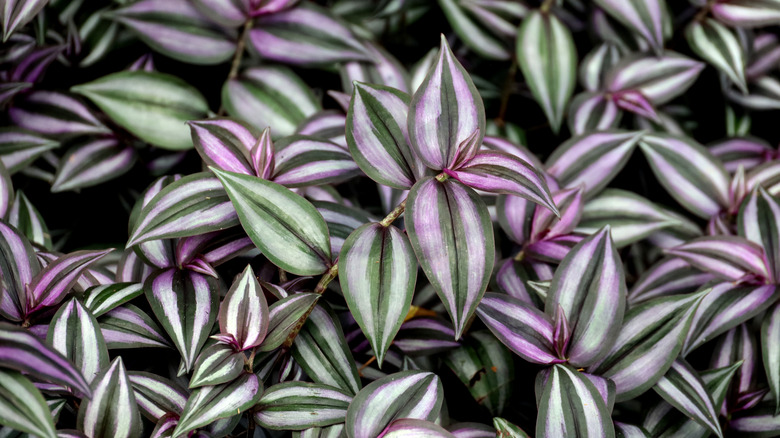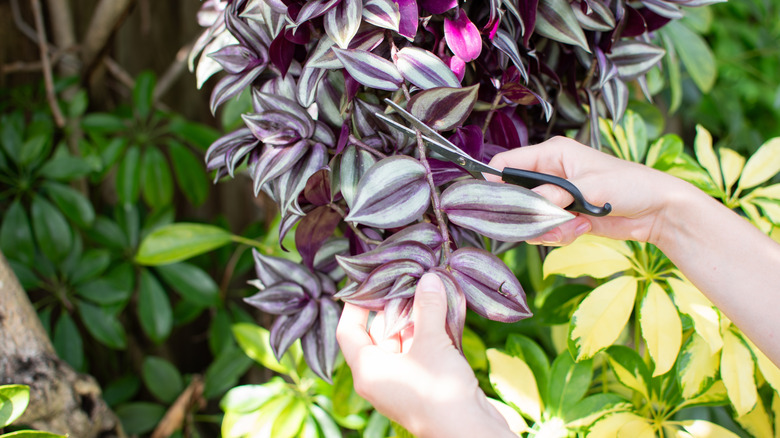Add A Subtle Pop Of Color With An Easy-To-Grow Indoor Plant
Variegation is a hot new trend for houseplants. If you're unfamiliar with variegation, it simply means that a plant's leaves feature various colors or a spectrum of one color, as well as different patterns. While the inch plant (Trandescantia zebrina) didn't make it on our list of top trending houseplants for 2025, its deep jewel-toned leaves — accented with silver brushstrokes — and low-maintenance care make it a popular indoor plant nonetheless.
While you might assume that the plant's name refers to its fast-growing nature, the inch plant moniker actually describes the distance between its leaf nodes. It is native to southern Mexico and parts of Central America — often grown as a groundcover in mild climates (USDA Hardiness zones 8 to 12) — and maxes out at a height of 6 to 8 inches and a width of 1 to 2 feet. Given its trailing habit, the inch plant is often grown in hanging baskets or dangling off a shelf. If you have pets, keep this plant out of reach since, it's toxic and can cause skin irritation, according to the ASPCA.
Caring for an inch plant
This eye-catching plant doesn't have any high demands and is perfect for even beginner plant parents. As a general rule of thumb, give it bright, indirect light. Interestingly, though, the inch plant responds to light differently depending on the climate: In northern (colder) climates, the markings on the inch plant's foliage become more pronounced and vibrant when it gets direct light. On the other hand, in southern (more tropical and humid) climates, the colors are susceptible to fading when exposed to excessive sunlight.
Inch plants thrive in well-drained soil and like to dry out a bit between waterings. However, to avoid root rot, don't pour water where the stems meet the roots (also known as the crown of the plant). Instead, water around the plant, ensuring that all the soil gets evenly wet. During spring and summer, when the plant is active, boost your inch plant's growth with diluted liquid fertilizer. Just be mindful of how often you fertilize these indoor plants — once a month should do.
Common pests that like the inch plant include mealybugs, aphids, and spider mites. To keep the plant pest-free, regularly inspect it for signs of unwelcome houseguests. If you see evidence of spider mites — like webbing, leaf discoloration, or tiny white or yellow spots — hydrogen peroxide is a common household product that will get rid of the pests.
Tips for easy inch plant propagation
With an inch plant, you can easily create babies without even trying. If it's growing along the surface of the soil, roots quickly emerge from the nodes. Cut the stems below the new roots and grow them as separate plants. Use clean shears to cut at least 4 inches off a stem, including at least two nodes. Cuttings can be placed in water until roots appear (be sure to remove leaves below the waterline to keep the water clean) or planted directly into the soil, burying at least one node. Otherwise, follow expert Hilton Carter's useful tips to propagate plants like a pro.
Not only does propagation give you more plants, but it also serves as pruning. Without frequent trimming, these plants can get quite leggy, especially with insufficient light. Taking shears to your plant triggers it to grow back fuller, giving it a more dense and healthy appearance. Another way to give your inch plant a bushier look is to tuck the ends of several stems into the dirt, covering at least one node for roots and new stems to form on.


